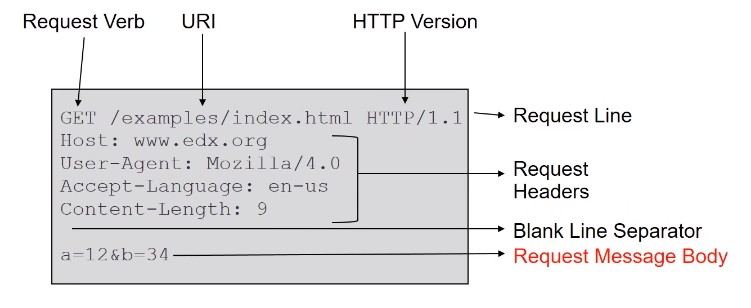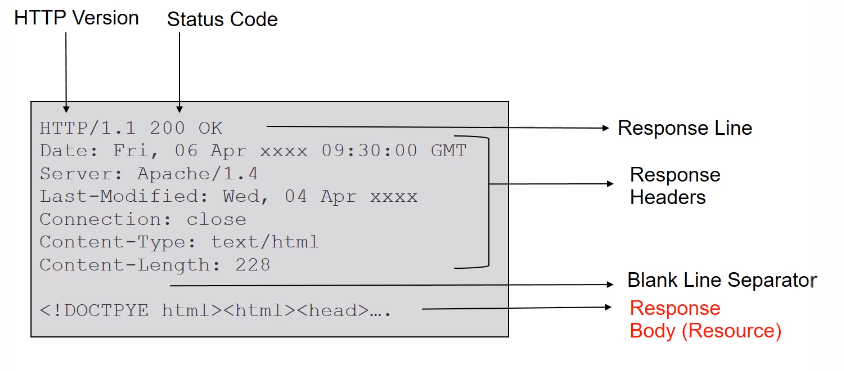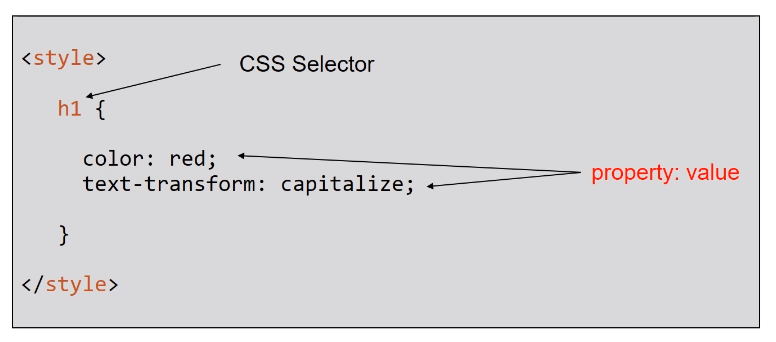PennX - SD4x
Anatomy of an HTTP Request
The first line of a request will always be a verb followed by an argument:
- GET: retrieve resource
- HEAD: retrieve only headers (information about the resource)
- POST: create resource (usually used in form submission context)
Anatomy of an HTTP Response
The first line of a response is always the protocol and status code. Following that comes other header information regarding the response and/or the server, then a blank line and the the response body, i.e. the resource that was requested.
CSS Syntax
Javascript
Truthy and falsy values:
- truthy values: 'test', 'false', 5, etc.
- falsy values: null, undefined, 0, NAN, '' (treated as false)
Any variable type can become a boolean when used with logical operators!
Arrays
Values stored can be of any type:
var myArray = ["cars", 12, false];
- When reading an array value by its index, the array will return undefined if the index is out of bounds, no exception!
- Elements can be written to negative indices and there can be gaps between elements, where no other element is
- e.g. a[1] = 'test', a[3] = 'another test' and a[2] is undefined, a.length will be 2 not 3
push()
Adds an element to the end of an array: e.g. myArray.push('wow');
unshift()
Adds an element to the start of an array: e.g. myArray.unshift('wow');
pop()
Removes and returns an element from the end of the array: e.g. var vehicle = myArray.pop();
shift()
Removes and returns an element from the beginning of the array: e.g. var vehicle = myArray.shift();
Objects
- Objects are used to store key-value pairs
- values can be of any type, including objects
- values can be accessed by myObject.property or myObject['property']
Example object declaration and modification:
var pet = {
name: "Cooper",
type: "dog",
};
console.log(pet.age); // undefined
pet.age = 11;
console.log(pet.age); // 11
pet["status"] = "good boy";
console.log(pet.status); // "good boy"
key-value pair age and status is added since it doesn't exist yet.
Control Structures
Keep in mind difference between comparisons "==" and "===":
== will compare different types and do conversions (1 == '1': true!)
== will do no conversions, simple comparison (1 === '1': false!)
Objects are only considered equal if the variables are aliases, i.e. refer to the same object:
var cooper = { age: 11 }
var flanders = { age: 11 }
if (cooper == flanders) { . . . } // false
var myDog = cooper;
if(myDog == cooper) { . . . } // true!
Functions
Example of a function:
function factorial(n) {
var product = 1;
for (var i = 1; i <= n; i++) {
product *= i;
}
return product;
}
var x = ...
var f = factorial(x);
console.log(f);
Array has predefined functions like:
- forEach, which executes a function for each element of the array (like linq).
- every, which evaluates each element against a function that returns either true or false (an int and a string can also be truthy so not literally true or false)
- map, applies a function to every element of the array and saves the result for each element in a new array
Pass by value vs Pass by reference
Primitive arguments are passed by value, the function cannot change them. Object arguments are passed by reference, the function can change them.
Functions as objects
Javascript functions are objects!
Therefore functions can take advantage of the benefits of an object, such as having properties
Since JavaScript functions are objects, they can be assigned to variables:
var add = function (a, b) {
return a + b;
};
console.log(add(3, 5)); // 8
JavaScript functions can also be declared and used in objects:
var johnDoe = {
name: "John Doe",
age: "32",
greeting: function () {
return " Hello! Nice Meeting You!";
},
};
console.log(johnDoe.greeting());
Object prototypes
- Every object in JavaScript has a prototype, accessed from the __proto__ property in the object.
- The __proto** property is also an object, with its own __proto** property, and so on
- The root prototype of all objects is Object.prototype
- An object inherits the properties of its prototype
Creating a prototype
- Prototypes are created like any other JavaScript function or object
- the this keyword refers to the current object
- the new keyword can be used to create new objects from the same prototype
function Person(name, age) {
// prototype
this.name = name;
this.age = age;
this.greeting = function () {
return "Hello! My name is " + this.name;
};
}
var johnDoe = new Person("John Doe", 32);
johnDoe.greeting(); // Hello! My name is John Doe
var janeDoe = new Person("Jane Doe", 28);
janeDoe.greeting(); // Hello! My name is Jane Doe
Extending prototypes
- Prototypes can extend another prototype with more functionality
- To inherit a prototype, set the __ proto__ property of an object to the parent prototype
function Student(name, age, school) {
this.__proto__ = new Person(name, age);
this.school = school;
}
var sarahBrown = new Student("Sarah Brown", 17, "PennX");
sarahBrown.greeting(); // Hello! My name is Sarah Brown
sarahBrown instanceof Person; // true
Prototype properties
- Properties and methods can be added to prototypes by adding them to the prototype property
var Person = function (name, age, occupation) {
this.name = name;
this.age = age;
this.occupation = occupation;
};
Person.prototype.planet = "Earth";
Person.prototype.introduction = function () {
return "I am a " + this.occupation;
};
var johnDoe = new Person("John Doe", 32, "Dentist");
johnDoe.planet; // Earth
johnDoe.introduction(); // I am a Dentist
JavaScript regular expressions
In Javascript strings are immutable!
var animal = "cat";
animal[0] = "r";
console.log(animal); // still cat
Functions that work on strings, like toUpperCase() therefore return a new string.
- A regular expression is a pattern of characters
- A string matches a regular expression if it adheres to the same pattern
- Example: "consists of exactly three digits (0-9)"
- '123' matches
- 'abc' does not match
- '12' does not match
- '12345' does not match
Simple regular expressions�
- We can pass a regular expression to the string's search function to see if it matches the pattern
- In general, it is considered a match if any part of the string matches the regular expression
var status = "I am working VERY hard";
status.search(/VERY/); // returns the position -> 13
status.search(/very/); // not found -> -1
status.search(/very/i); // ignores case -> 13
We can also use the regex test function:
/script/.test("javascript is so much fun!"); // true
Ranges of characters
var numbers = "5 8 2 5 7 6";
numbers.search(/[012]/); // 4
var password = "password4real";
password.search(/[a-z]/); // 0
password.search(/\d/); // 8 (any digit)
var code = "abc123d4e5";
code.search(/[0-9][a-z][0-9]/); // 5
var chars = "abc123K456";
chars.search(/[^0-9a-z]/); // look for characters not in range -> 6
Quantifiers
/[a-z][0-9]?[a-z]/.test("a1b"); // matches
/[a-z][0-9]?[a-z]/.test("abc"); // matches -> number is optional
/[a-z][0-9]?[a-z]/.test("a123b"); // doesn't match -> ? tests for single occurrence
/[a-z][0-9]*[a-z]/.test("a123b"); // matches -> * tests for multiple occurrence
startsWith and endsWith Matches
/^[a-z][0-9]/.test("a1b"); // ^ starts with -> true
/^[a-z][0-9]/.test("ab12"); // false
/[a-z][a-z]$/.test("123abc"); // $ ends with -> true
/[a-z][a-z]$/.test("123abc456"); // false
Event-driven programming
- Event-driven programming can be used to modify HTML based on user input
- This is done by defining callback functions and associating them with various events by adding event listeners
- element.addEventListener(event, function)
- Events: 'click', etc.
jQuery
- simplifies JavaScript usage on webapps
- more intuitive way of DOM manipulation
- great cross-browser support (except IE6)
- additional utilities
- effects and animations
- customizable plugins
Selecting DOM Elements
- in jQuery, $ is used to select DOm elements for manipulation, along with basic CSS element syntax
- $("*") selects all elements
- $(this) selects the current element
- $("div") selects all
<div>elements - $(".title") selects all elements with class="title"
- $("#name") selects the element with id="name"
jQuery DOM Manipulation
- to manipulate DOM contents, the general format is $(selector).action(arguments)
- Examples:
$("#name").html("Hello"); // set html of element with id name to Hello
$("#name").append("World!"); // append World! to element with id name
$("#name").addClass("greeting"); // add class
$("#name").hide(); // hide element
$("#name").show(); // unhide element
- to add an event listener to an element, the general format is $(selector).event(callback)
Selectors
$(someNodes).find(selector); // will search someNodes' children for selector
$("div.book"); // selects divs with class="book"
$("div, .book"); // selects all divs and all elements with class="book"
$("p:hidden"); // selects all <p> elements that are visually hidden
ES5 vs ES6
Arrow functions
ES5 Syntax:
var square = function (n) {
return n * n;
};
ES6 Syntax:
let square = (n) => {
return n * n;
};
Default Parameter Values
function pow(base, power = 2) {
return Math.pow(base, power);
}
console.log(pow(3)); // 9
Template Literals
var person = { name: "Lydia" };
var msg = `Dear ${person.name}, // This will even create a new line!
How are you?`;
Note: Notice that the backtick character ` is used instead of the normal ' character!
Classes
ES5 Syntax:
var Rectangle = function (height, width) {
this.height = height;
this.width = width;
};
Rectangle.prototype.area = function () {
return this.height * this.width;
};
ES6 Syntax:
class Rectangle {
constructor (heightm width){
this.height = height;
this.width = width;
}
}
area() {
return this.height * this.width;
}
New Data Structures
ES6 also introduces the Set class
- Collection of Elements
- Elements are distinct
- Elements maintain their order
- Comparable to C# List (which can have duplicates though)
ES6 also introduces the Map class
- Collection of Key - Element pairs
- Comparable to C# Dictionary
D3.js - Data driven documents
- D3.js is a JavaScript library for manipulating HTML documents based on data
- Data can be bound to DOM elements (HTML, SVG) and then we can programmatically apply data-driven transformations
- This can be used for generating HTML tables, SVG charts and graphs, etc.


